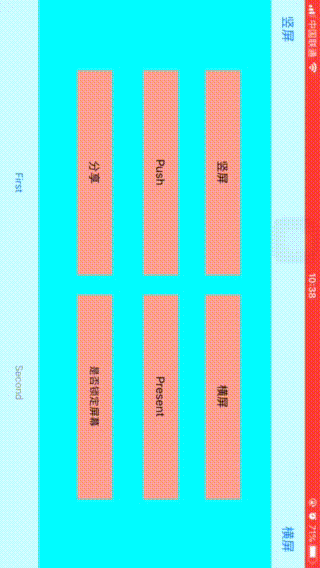在做视频开发时遇到屏幕旋转问题,其中涉及到 StatusBar、 UINavigationController、UITabBarController 、UIViewcontroller。
主要涉及以下4点:
- 横竖屏的旋转
- 屏幕旋转相应改变视图位置
- 旋转时状态栏的隐藏与显示
- 锁屏
- 第1步:
-(UIInterfaceOrientationMask)application:(UIApplication *)application supportedInterfaceOrientationsForWindow:(UIWindow *)window {
// NSLog(@"0000000---------%@",NSStringFromClass([[self topViewController] class]));
// if ([NSStringFromClass([[self topViewController] class]) isEqualToString:@"FirstViewController"]) {
// //横屏
// return UIInterfaceOrientationMaskLandscapeRight;
// }
// //竖屏
// return UIInterfaceOrientationMaskPortrait;
NSUInteger orientations = UIInterfaceOrientationMaskAllButUpsideDown;
if(self.window.rootViewController){
//取出当前显示的控制器
UIViewController *presentedViewController = [self topViewControllerWithRootViewController:self.window.rootViewController];
//按当前控制器支持的方向确定旋转方向(将旋转方向重新交给每个控制器自己控制)
NSLog(@"%s, line = %d",__FUNCTION__,__LINE__);
orientations = [presentedViewController supportedInterfaceOrientations];
}
return orientations;
}
//获取界面最上层的控制器
//- (UIViewController*)topViewController {
// NSLog(@"%s, line = %d",__FUNCTION__,__LINE__);
// return [self topViewControllerWithRootViewController:[UIApplication sharedApplication].keyWindow.rootViewController];
//}
//一层一层的进行查找判断
- (UIViewController*)topViewControllerWithRootViewController:(UIViewController*)rootViewController {
NSLog(@"%s, line = %d",__FUNCTION__,__LINE__);
if ([rootViewController isKindOfClass:[UITabBarController class]]) {
UITabBarController* tabBarController = (UITabBarController*)rootViewController;
NSLog(@"Tabbar:%@",NSStringFromClass([tabBarController.selectedViewController class]));
return [self topViewControllerWithRootViewController:tabBarController.selectedViewController];
} else if ([rootViewController isKindOfClass:[UINavigationController class]]) {
UINavigationController* nav = (UINavigationController*)rootViewController;
NSLog(@"nav:%@",NSStringFromClass([nav.visibleViewController class]));
return [self topViewControllerWithRootViewController:nav.visibleViewController];
} else if (rootViewController.presentedViewController) {
NSLog(@"present:%@",NSStringFromClass([rootViewController.presentationController class]));
UIViewController* presentedViewController = rootViewController.presentedViewController;
return [self topViewControllerWithRootViewController:presentedViewController];
} else {
NSLog(@"root:%@",rootViewController);
return rootViewController;
}
}
代码中通过 -(UIInterfaceOrientationMask)application:(UIApplication *)application supportedInterfaceOrientationsForWindow:(UIWindow *)window 方法将控制器交给自己控制,该方法默认值为Info.plist中配置的Supported interface orientations项的值。
- 第2步:在各控制器设置支持的方向
//是否允许旋转(默认允许)
- (BOOL)shouldAutorotate {
return YES;
}
- (UIInterfaceOrientationMask)supportedInterfaceOrientations{
//允许旋转的方向
return UIInterfaceOrientationMaskAll;
}
其中- supportedInterfaceOrientations 方法在 iPad 中默认取值为 UIInterfaceOrientationMaskAll,即默认支持所有屏幕方向;而 iPhone 跟 iPod Touch 的默认取值为 UIInterfaceOrientationMaskAllButUpsideDown,即支持除竖屏向下以外的三个方向。
在设备屏幕旋转时,系统会调用 - shouldAutorotate 方法检查当前界面是否支持旋转,只有 - shouldAutorotate 返回 YES 的时候,- supportedInterfaceOrientations 方法才会被调用,以确定是否需要旋转界面。
这个是 TabbarController 中设置的,它会影响关联的 UIViewController 的支持方向,需要在 UIViewController 中进一步设置
//此方法来控制能否横竖屏 控制锁屏
- (UIInterfaceOrientationMask)supportedInterfaceOrientations {
NSLog(@"%s, line = %d",__FUNCTION__,__LINE__);
UIInterfaceOrientationMask inter;
if (_lockScreen) {
switch (_lockOrientation) {
case 1:
inter = UIInterfaceOrientationMaskPortrait;
break;
case 2:
inter = UIInterfaceOrientationMaskPortraitUpsideDown;
break;
case 3:
inter = UIInterfaceOrientationMaskLandscapeRight;
break;
case 4:
inter = UIInterfaceOrientationMaskLandscapeLeft;
break;
default:inter = UIInterfaceOrientationMaskAll;
break;
}
} else {
inter = UIInterfaceOrientationMaskAll;
}
//支持全部方向
return inter;
}
- 第3步:强制转换控制器方向
- (void)setInterOrientation:(UIInterfaceOrientation)orientation {
if ([[UIDevice currentDevice] respondsToSelector:@selector(setOrientation:)]) {
SEL selector = NSSelectorFromString(@"setOrientation:");
NSInvocation *invocation = [NSInvocation invocationWithMethodSignature:[UIDevice instanceMethodSignatureForSelector:selector]];
[invocation setSelector:selector];
[invocation setTarget:[UIDevice currentDevice]];
int val = orientation;
// 从2开始是因为0 1 两个参数已经被selector和target占用
[invocation setArgument:&val atIndex:2];
[invocation invoke];
}
}
- 第1步:监听
UIDeviceOrientationDidChangeNotification状态
//监听设备旋转 改变 视图 对应位置
[[NSNotificationCenter defaultCenter] addObserver:self selector:@selector(deviceOrientationDidChange) name:UIDeviceOrientationDidChangeNotification object:nil];
//用来控制横竖屏时调整视图位置
- (void)deviceOrientationDidChange
{
[self isPortrait];
}
- 第2步:重新布局
if (_interOrientation == UIInterfaceOrientationPortrait || _interOrientation == UIInterfaceOrientationPortraitUpsideDown) {
self.top.constant = 145;
self.bottom.constant = 210;
} else if (_interOrientation == UIInterfaceOrientationLandscapeRight || _interOrientation == UIInterfaceOrientationLandscapeLeft) {
self.top.constant = 40;
self.bottom.constant = 50;
}
- 这里只记述旋转时状态栏的变化,由竖屏想横屏变化时状态栏会消失。
//在需要的`UIViewController`设置是否隐藏
- (BOOL)prefersStatusBarHidden {
NSLog(@"%s, line = %d",__FUNCTION__,__LINE__);
return NO;
}
锁屏时,不管系统锁屏是否关闭、Push 或 Present 返回后,界面依然保持不变。
- 第1步:设置锁屏
- (IBAction)lockAction:(UIButton *)sender {
if (_lockScreen) {
_lockScreen = NO;
[sender setTitle:@"锁定屏幕" forState:UIControlStateNormal];
} else {
_lockScreen = YES;
[sender setTitle:@"解开屏幕" forState:UIControlStateNormal];
}
_lockOrientation = _interOrientation;
}
- 第2步:绕过强转
- (void)interfaceOrientation:(UIInterfaceOrientation)orientation
{
[self isPortrait];
//锁屏情况下 不旋转
if (!_lockScreen) {
[self setInterOrientation:orientation];
}
- 第3步:针对 Push 或 Present 返回后
- (void)viewWillAppear:(BOOL)animated {
if (_lockScreen) {
//记录返回时的界面状态
[self setInterOrientation:_lockOrientation];
} else {
[self isPortrait];
}
}
-(UIInterfaceOrientationMask)application:(UIApplication *)application supportedInterfaceOrientationsForWindow:(UIWindow *)window {
if ([NSStringFromClass([[self topViewController] class]) isEqualToString:@"FirstViewController"]) {
//横屏
return UIInterfaceOrientationMaskLandscapeRight;
}
//竖屏
return UIInterfaceOrientationMaskPortrait;
}
